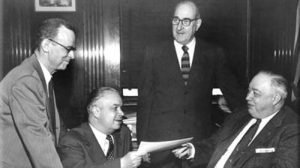The L.P. Cookingham Institute takes its name from Laurie Perry Cookingham (October 23, 1896 – July 22, 1992), more commonly known as L.P. Cookingham or L. Perry Cookingham. L.P. Cookingham served as city manager of Kansas City, Missouri, for 19 years, a tenure longer than anyone else had served as city manager in any city in the United States at that time. His distinctively long tenure earned him the respect of many of his colleagues, some of whom dubbed him the “Dean of City Managers.”
L.P. Cookingham was hired in 1940 with the mandate of reforming Kansas City’s corrupt administration. Over the previous 15 years, city government had been ruled by Tom Pendergast and city manager Henry F. McElroy. While this era produced much of the city’s most iconic infrastructure including City Hall, Municipal Auditorium and the Nelson Atkins Museum of Art, the period was also marked by lax enforcement of liquor laws, patronage hiring and no-bid city contracts. In 1940, a new city council hoped that L.P. Cookingham would bring professional management to city government in Kansas City.
Cookingham began his tenure with the city $20 million in debt. He reduced the city workforce by 2,000 people in the first six months and eliminated the city’s debt within two years. The city also underwent enormous territorial expansion during his tenure. Kansas City more than doubled in land area from 60 to 130 square miles, mostly through extensive annexation of territory north of the Missouri River.
When the Great Flood of 1951 devastated the Kansas City Stockyard and destroyed major facilities belonging to the city’s two home-based airlines, Mid-Continent and TWA, Cookingham oversaw the construction of a brand new jet port that would become Kansas City International Airport. Cookingham Road, the main road into the airport, is named for him. L.P. Cookingham is also credited in a large part with planning the freeway system in the metropolitan region.



